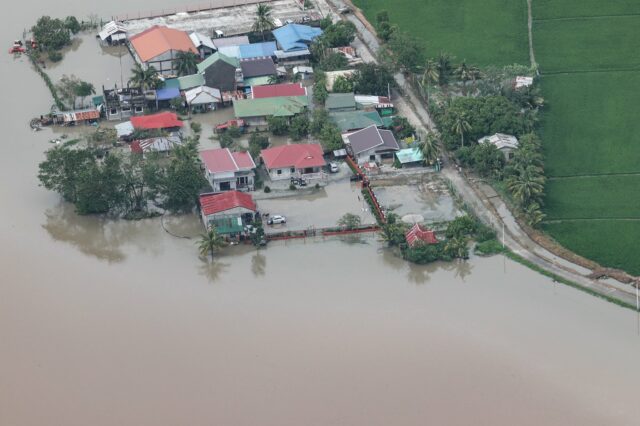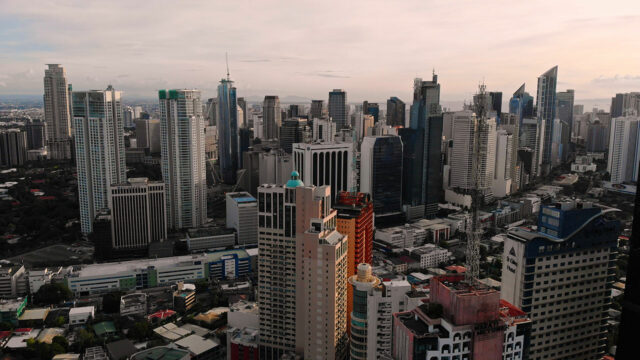MILAN — Dolce & Gabbana teamed up with US reality TV star Kim Kardashian at Milan Fashion Week on Saturday as the Italian luxury label presented its latest collection for women’s wardrobes. (Watch the show here: https://www.dolcegabbana.com/en/ ).
To the backdrop of a giant screen showing a black and white video of Kardashian eating spaghetti, models wore embellished corset dresses, crop tops with high-waisted tight trousers, and shimmering or see-through frocks. Skirts were long and slim while jeans were torn or embellished.
Some models wore large chokers reading “KIM” or “LOVE.”
The color palette consisted of mainly black, white, shiny silver, with added touches of leopard print.
The label, headed by designer duo Domenico Dolce and Stefano Gabbana, had teased the #CiaoKim collaboration ahead of the show with short videos of Ms. Kardashian being photographed by paparazzi.
Ms. Kardashian, dressed in a sparkly black dress, closed the event by greeting the audience followed by designers Dolce and Gabbana.
VERSACE
Italian luxury label Versace mixed tiaras and studs for its latest womenswear creations at Milan Fashion Week, offering a collection it called “a goddess gone grunge” for next spring. (See the show here: Versace Spring-Summer 2023 Women’s | Fashion Show | Versace ).
Designer Donatella Versace opened the show late on Friday with all black looks, including tight-fitting dresses slashed at different angles. Black biker jackets and leather trousers had fringes or metal studs.
Pink and purple designs followed, including long dresses with deep cowl necklines, flared trousers and long zebra print chiffon shirts.
“I have always loved a rebel. A woman who is confident, smart and a little bit of a diva,” Donatella Versace said in a statement.
“She wears leather, studs and frayed denim and she has enough attitude to mix them with chiffon, jersey, and a tiara! She is a strong liberated woman; she is gorgeous; she knows it. She is the Goddess of Freedom.”
The last looks included short and long lace-trimmed dresses in purple, pink and lime, accessorized with veils in the same color.
US reality television star Paris Hilton closed the show in a short pink crystal mesh bridal dress with lace trims, accessorized with a pink veil and tiara.
GUCCI
Fashionistas saw double at Gucci’s Milan Fashion Week show on Friday, with the Italian luxury label surprising audiences by sending identically dressed twins down the catwalk. (See show here: www.gucci.com/us/en/st/gucci-twinsburg-fashion-show#video-1 ).
Creative director Alessandro Michele paid homage to twins and their bond for the show, called Gucci Twinsburg, a nod to the Ohio town which holds a yearly festival for twins.
The presentation began with single models walking down the catwalk, before a wall was lifted to show their brothers or sisters on the other side in the exact same outfits. The siblings held hands as they walked together in a striking finale.
“I am a son of two mothers: mum Eralda and mum Giuliana. Two extraordinary women who made their twinship the ultimate seal of their existence,” Mr. Michele said in show notes. “They lived in the same body. They dressed and combed their hair in the same way. They were magically mirrored. One multiplied the other. That was my world, perfectly double and doubled.”
Mr. Michele’s designs began with a black blazer jacket teamed with suspender-like trouser legs, followed by a bright red belted dress. Biker jackets were paired with skirts bearing cutouts, shimmering silver jackets were cropped and had large shoulders, while prints on colorful dresses depicted spanners and bolts.
Models also wore floor-length trench coats, floral kimono-inspired designs, and ruffled silk dresses, among an eclectic mix of looks. Accessories included long beaded jewelry and sunglasses, leopard print tights, and snakeskin boots.
EMPORIO ARMANI
Emporio Armani sought to bring a touch of “freedom and openness” to women’s wardrobes for next spring, with the Italian designer brand presenting a light travel-inspired collection at its latest catwalk show at Milan Fashion Week.
Veteran designer Giorgio Armani opened the presentation for his second label with lightly-colored looks made up of fluid jackets and loose trousers accessorized with black berets and bags. (View the show here: https://www.armani.com/en-us/experience/emporio-armani/fashion-show-spring-summer-women).
Models wore long shirts over trousers, sarong-like skirts and loose tops — all with flat shoes — at the show, held on Thursday afternoon.
“This collection expresses an idea of freedom and openness,” Mr. Armani said in a statement, adding that he wanted to give everyday wear the lightness of holiday looks.
Designs came in shades of blue, green, turquoise and mauve. For the evening, there were beaded tops, shimmering and embroidered sheer dresses in pastel hues.
Armani will present the latest collection for his main line, Giorgio Armani, on Sunday, the penultimate day of Milan Fashion Week.
PRADA
Simplicity and contrasts were the main themes at the Prada catwalk show in Milan on Thursday, with the Italian luxury label stripping off “unnecessary complication” in its latest womenswear collection. (View the show here https://www.prada.com/ww/en/pradasphere/fashion-shows/2023/ss-womenswear.html).
Designers Miuccia Prada and Raf Simons opened the Spring/Summer 2023 show with sharp grey looks including pointy-collared shirts, slim-fit trousers and a jumpsuit.
Reinforcing the idea of simplicity were sleeveless dresses made with a paper base fabric. The frocks bore slits at the front, creases and folds.
“The clothes are about simplicity, with no unnecessary complication,” Miuccia Prada said in a statement. “There is no complicated structure, nothing unnecessary. No nonsense — the rawness, the crudeness represents absolute simplicity. We wanted to do something with the most simple, modest material — with paper. Then we used this system of reduction and simplicity as a means of making beauty.”
Outerwear consisted of light opera coats and black leather jackets. Some coats had large bows at the back.
Last season’s sheer looks continued at Thursday’s show, with models wearing transparent tops and skirts.
The designers, who worked with film director Nicolas Winding Refn for the show, stuck to a minimalist color palette of grey, white, black with bursts of bright lime, orange, and red occasionally appearing on tops, handbags or shoes. — Reuters






















